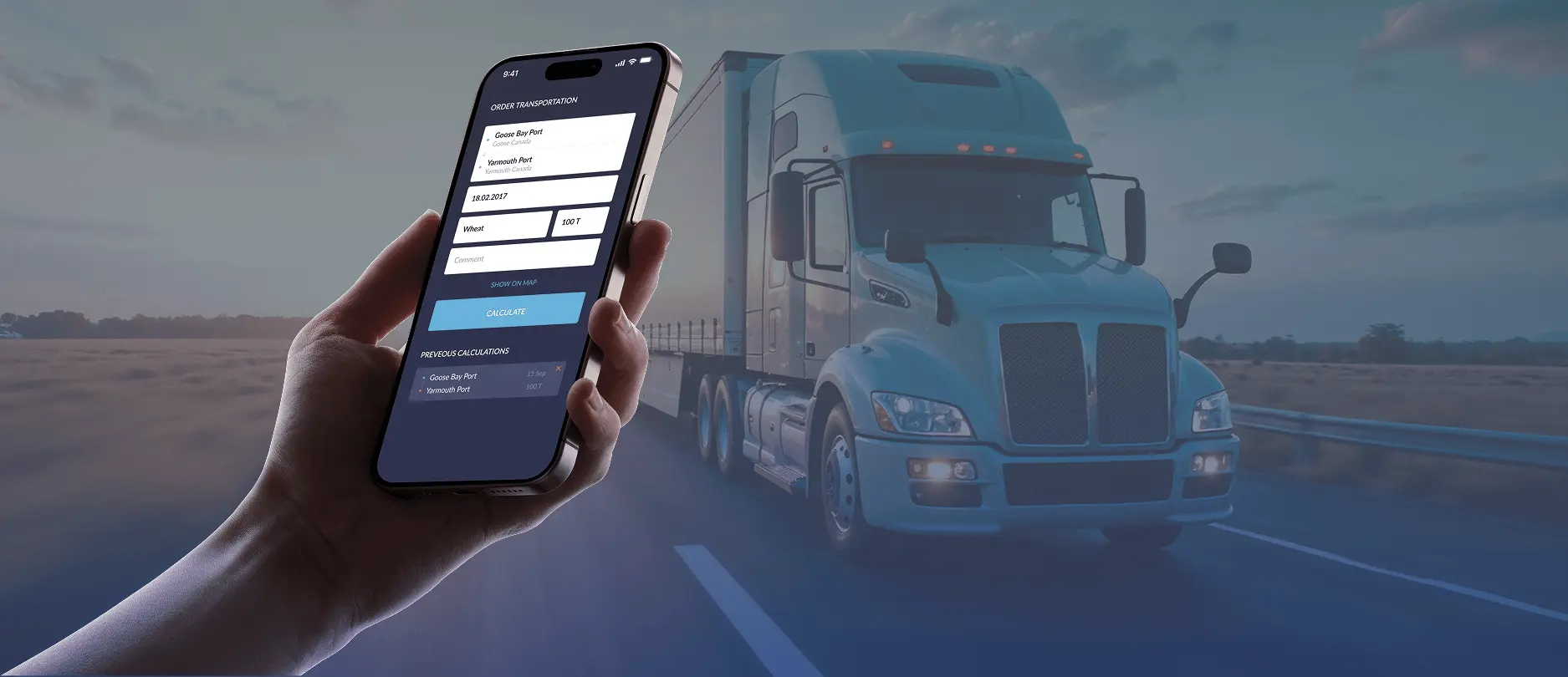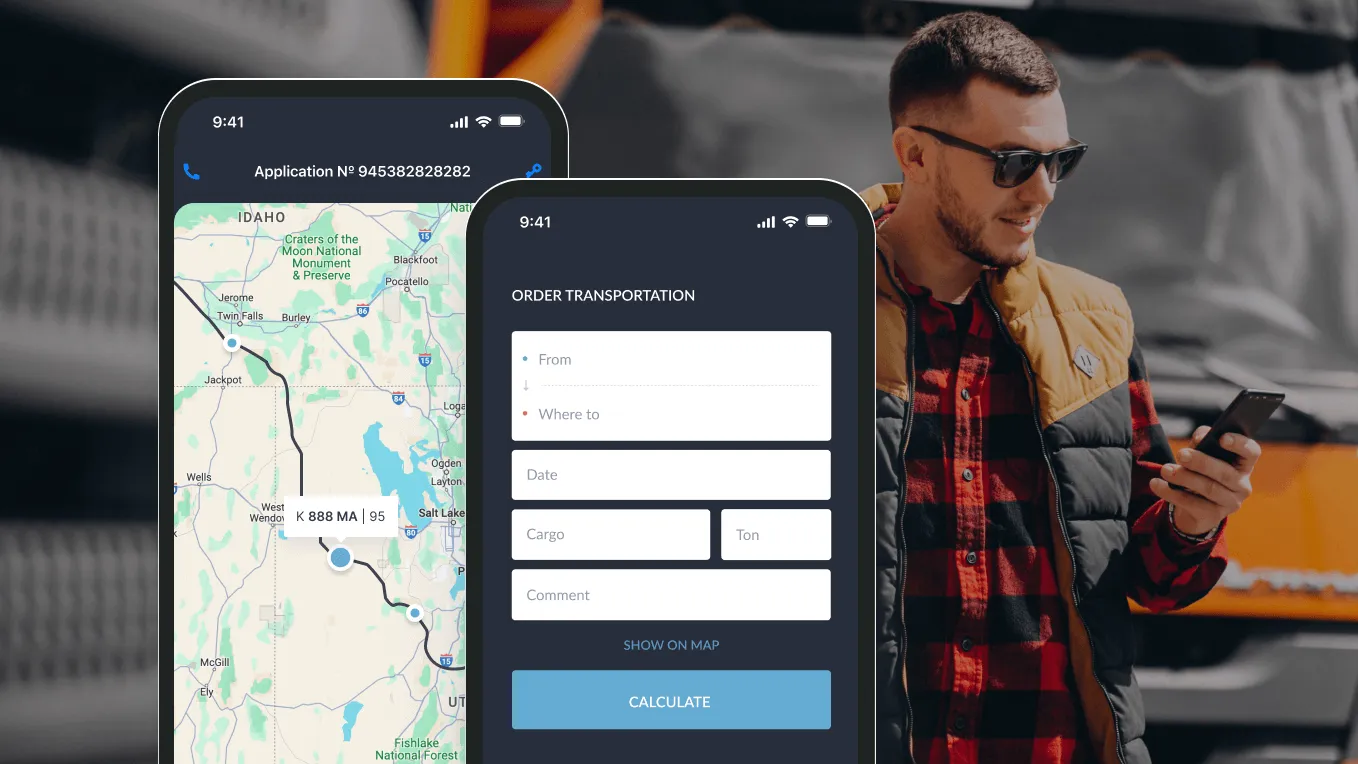
Uber Freight set the bar, but the game is far from over. You're not just looking to build 'another' trucking app; you're aiming to outmaneuver the giants, to carve out your own space in the digital logistics arena. But how do you build a platform that not only replicates, but also innovates and surpasses?
Today, we will explain how to create an Uber-style app for your trucking business. We will highlight best practices from successful brands like Uber Freight and discuss how to do even better than them.
Stfalcon is hands-on with developing applications for the logistics industry. Over the past 15 years, we have successfully completed dozens of projects in this niche, so it is certainly not uncharted territory. Let us share the insights we’ve gathered through the years.
Choosing the Right Development Approach
Building a truck app like Uber Freight requires careful consideration of how to build it. Do you want a solution built just for you, or would a white-label platform, which can get you up and running faster, be a better choice? Your choice would affect scalability, costs, and long-term success. Let's break down the options.
Custom-built vs. White-label Solutions
- Custom-built solutions permit total control of features, UI/UX, and scalability. They are designed for businesses that want innovation and differentiation. A larger initial investment and more development time are needed for this option.
- White-label solutions help you enter the market quickly and easily. They include pre-built features that reduce the time required to develop a truck management app. Customization is limited, and scalability can become an issue as the business grows.
The more complex, safe, real-time, scalable, and integration-reliant the app, the more likely it is to need focused and expert development. Simple apps offer more flexible, less expensive development options.
Tech Stack Recommendations
Backend: Some popular options are Node.js (event-driven, great for real-time tracking), Python (AI/ML capabilities for route optimization), or Java (enterprise-grade reliability). For one of Stfalcon’s projects in this niche, we chose PHP-framework Symfony, our go-to backend framework, for the realization of service logic, since this is where our truck booking app development company has the biggest experience.
Frontend: For a trucking app, you can choose a reliable path of native development for iOS and Android, or opt for cross-platform solutions like Flutter or React Native.
Cloud Services:
- AWS (Amazon Web Services) offers a comprehensive suite of services, including compute, storage, databases, and machine learning. AWS Lambda can be used for serverless functions, and Amazon S3 can store large files.
- Google Cloud Platform (GCP) provides similar services to AWS, with a strong focus on data analytics and AI. Google Cloud's BigQuery can be used to analyze large datasets of freight data.
Architecture:
- Monolith: A single, unified application. Suitable for smaller projects or MVPs, easier to develop initially. However, it can become difficult to maintain and scale as the application grows.
- Microservices: An architecture where the application is composed of small, independent services. This offers more flexibility, scalability, and resilience. You could possibly have separate microservices for driver management, load matching, and payment processing. This architecture is more complex to implement but provides greater flexibility for large-scale applications, similar to how Uber itself manages its many services.
One key factor in determining the development approach you choose is the list of features you want to implement in your future app.
Want a web app that does more?
Let's build a solution that's smart, sleek, and powerful.
Alina
Client Manager

Core Features of a Trucking App Like Uber Freight
A successful trucking solution will require three separate applications: for truckers, shippers, and admins. For the latter, it is worth creating a web version for convenience, while cargo owners and drivers can get mobile-first apps. To release an MVP, it is worth focusing on the most basic features and the ones that bring the main value and help the app stand out from the competition. Here you can see the examples of features implemented by Uber Freight and its main competitors.
Basic Features
These are the foundational elements for any functional trucking app. Without them, the app wouldn't serve its core purpose. To develop an Uber-like trucks application, the list of basic features would include:
- Registration and Login
- Admin panel (dashboard to manage orders, shippers, carriers)
- Order Placing (input of pickup/dropoff, weight, size)
- List of Vehicles (category selection)
- Payments and Invoice Viewing
- Request Management (for truckers)
- Route Optimization and Tracking
- Order Notifications
Core Features
These features provide a competitive edge, enhancing user experience and efficiency. They address specific pain points in the trucking industry and add real value.
For Shippers:
- Real-Time Order Tracking: A live map view allows shippers to monitor the position of their freight and the estimated arrival time at any time with live updates.
- Vehicle Booking: One of the advanced pre-booking options allows shippers to pre-book trucks according to availability, cargo types, and preferred carriers.
- Online Documentation: Smooth access to permits, invoices, and regulatory documents guarantees hassle-free, compliant freight management.
- Ratings and Reviews: Shippers can make sensible decisions about carriers based on clear performance reviews by other users.
For Carriers (Truckers):
- Detailed Order History: A comprehensive record of completed and upcoming deliveries, including earnings breakdowns and performance analytics.
For Admins:
- Advanced Matching Algorithm: AI-driven load matching optimizes pairings between shippers and carriers based on pricing, availability, and route efficiency.
- Vehicle Tracking: Real-time telemetry provides exact location updates, fuel consumption metrics, and driving behavior analytics.
- Driver Surveillance: Automated monitoring tools, including dashcam integrations and speed tracking, ensure compliance with safety regulations.
- Invoice Management: A built-in invoicing system automates payment processing, reducing delays and administrative overhead.
- Geo-Fencing: Custom geofencing alerts notify admins when vehicles enter or exit designated zones, improving security and operational control.
- Highly Advanced Security: End-to-end encryption, multi-factor authentication, and fraud detection mechanisms protect sensitive user data and financial transactions.
The list of features can (and probably will) be changed over time, but the initial version is worth having at the earliest stages of development.
Development Roadmap: How to Build a Trucking App Step by Step
While Uber Freight is the most advertised and probably the most well-known application in its niche, it is certainly not the only one. With a deep understanding of the market and a skilled team, you can turn your app idea into a strong competitor. Your app can even match or surpass popular services like Uber Freight.
Let’s walk through the basic stages of an Uber-like truck app development.
Phase 1: Planning
Before you start developing your app, plan your project carefully. Answer key questions and define the unique value your app will offer. Here are some ideas you can use at this stage:
- Define Unique Proposition & Differentiators from Competitors. Try to go beyond basic matching. Uber Freight focused on simplifying load matching and providing transparent pricing. To truly differentiate, consider niche specializations. For example, instead of just general freight, specialize in temperature-controlled logistics, or focus on 'last-mile' delivery for businesses with high-volume, time-sensitive needs within urban areas. Consider the user base. Will this be a regional app, or national?
- Consider Driver-Centric Features. Many platforms focus on shippers. To attract and retain drivers, prioritize their needs. An example would be a 'driver loyalty program' that rewards drivers with higher-paying loads and priority access to support based on their performance and tenure.
- Define Pricing Model. Will you follow Uber Freight’s commission-based model, or offer a subscription service like Convoy’s freight bundling discounts for high-volume shippers?
- Add Exclusive Features. Consider offering real-time bidding (similar to Uber Freight’s bidding option), digital freight contracts, or IoT integration for cargo temperature monitoring, which is crucial for perishable goods.
To make this process easier, you can use proven business tools like Lean Canvas. If you need more help, consider working with a software development vendor and think about starting with a discovery phase.
Uber Freight initially launched with basic load matching and pricing transparency—solving a major pain point in traditional freight brokerage. They first proved there was demand in the market. After that, they added features for bidding, contracted freight, and tools for managing fleets. Using an MVP-first strategy can help you test your business model before making a big investment.
Planning carefully helps your app compete with established freight platforms. It also ensures that your app can grow and meet legal requirements.
Phase 2: UX/UI Design & Prototyping
If you want to build an app like Uber for trucks, you should pay attention to one of the key factors of its success: how easy it is to use. A user-friendly design will attract users and make it easy to navigate the truck app. This will lead to higher adoption rates and greater user engagement. This phase is crucial for converting your vision into an actual, user-friendly product.
At Stfalcon, we usually begin developing the user journeys, in this case, that of the truckers and the shippers. The focus here is on their specific needs and pain points. Next, we construct wireframes that visually articulate these journeys, really leaning in on specific features that make our app unique. Prototyping is the best way to validate the design we created. Interactive prototypes, built with tools like Figma, simulate the core functionalities important in testing the user experience before committing to development.
The most important factor for a trucking app is its ease of use. Truckers need to access the app while on their routes, so it must be straightforward and user-friendly. Hence, when designing, think big buttons that can be tapped easily and an interface with high contrast to remain visible through changing light conditions. Creating a ‘night mode' with a dark background and bright text alongside voice command functionality will enhance usability and safety. Meanwhile, the shippers will find a streamlined interface that helps them easily access relevant information through a clear dashboard, a powerful search engine, and filtering options.
Uber Freight started with a simplified mobile-first UI that mirrored the Uber ride-sharing app because it was familiar to the drivers. This rapid prototyping approach was supposed to accelerate adoption and reduce onboarding friction.
Phase 3: MVP Development
To quickly build an app like Uber for trucks, test it and get feedback from real users, you will launch the first minimum viable product (MVP). Building a complete platform takes time and effort. However, you can launch a minimum viable product (MVP) quickly with just the essential features needed for real learning and user feedback. This approach helps you make better decisions for future development. This is precisely what Uber Freight and Convoy have done: targeting the core functionalities first before going for advanced ones.
Uber Freight launched with a limited set of features: load matching, real-time tracking, and pricing transparency—all of which kept in view Uber's simplicity in its ride-hailing app. While users were being introduced to these features, they also did not feel overwhelmed by the complexities of other features.
In this stage of building or improving the product, we must constantly prioritize. Our main focus will be on developing the core functions of our platform that meet the important needs of our target users. While not setting out to achieve perfection, the goal is to build a functional platform that provides some immediate benefit. Given the MVP, it will allow a quick go-to-market exit with minimal risk and a clear understanding of the next step for subscription.
Phase 4: Testing & Deployment
Once your MVP is ready, intensive testing and optimization are crucial to a successful launch. The logistics industry has to be safe, trustworthy, and scalable. Problems can derail shipments, result in monetary losses, or compromise sensitive data even with minor issues. A trucking app handles financial transactions, sensitive business data, and real-time GPS tracking, making security and performance testing crucial.
- Load Stress Testing: Ensure the app can handle peak traffic, such as when multiple shippers post loads simultaneously.
- Data Encryption & Compliance: Secure user data with AES-256 encryption and role-based access control (RBAC) to meet regulations like GDPR and CCPA.
- Payment & Fraud Protection: Implement multi-factor authentication (MFA) and fraud detection systems to prevent unauthorized bookings or rate manipulations.
- API Reliability Testing: Logistics apps rely heavily on third-party APIs (e.g., Google Maps, payment gateways). Test for downtime scenarios and fallback mechanisms.
Once your main platform is stable, concentrate on scaling it up and adding advanced features. This will help improve efficiency and broaden your market reach.
Key Challenges in Truck App Development — and How to Solve Them
Logistics is one of the most complex and regulated industries. This can create many challenges in the process of Uber-like app development for trucking.
Data Management
Managing the large amount of data in logistics can be very challenging. This includes details on shipments, vehicle tracking, user profiles, and payment information. Without robust systems, errors and security breaches are inevitable.
Solution: To protect sensitive information, use a scalable, cloud-based database with real-time syncing, encrypt data, and conduct regular security audits.
Integration with Existing Systems
Many logistics companies rely on legacy ERP and GPS tracking systems, which may not seamlessly integrate with modern applications, leading to data silos and inefficiencies. A thorough evaluation of existing systems for compatibility is crucial.
Solution: Utilizing well-defined APIs to facilitate seamless data exchange will minimize manual input, reduce errors, and streamline workflows, ultimately enhancing overall system efficiency.
User Adoption
Carriers, shippers, and internal teams may not want to use a digital solution. This is especially true if they are used to manual booking and paper processes. Overcoming this resistance requires a strategic approach.
Solution: Prioritizing a user-friendly interface and providing comprehensive tutorials will ease the transition. Launching a minimum viable product (MVP) is important to collect early feedback. This feedback will help us improve features based on user experiences and encourage more people to use it.
Carrier Credibility
Allowing unreliable carriers onto the platform increases the risk of fraud, shipment delays, or lost cargo, damaging business reputation. Carriers must go through a thorough vetting process to verify carriers' reliability before approving them for shipments.
Solution: Implement a strict vetting process that verifies carrier credentials, past performance, and compliance before granting shipment access.
Cargo Insurance
Minimizing the risks associated with cargo damage or loss is crucial for maintaining customer trust and protecting the business from financial liability.
Solution: Make cargo insurance mandatory or offer integrated insurance options to ensure financial protection for both shippers and carriers.
Double-Booking Prevention
Multiple carriers could accept the same shipment without a proper booking system, leading to delays, confusion, and customer dissatisfaction.
Solution: Implement an intelligent booking algorithm that prevents duplicate reservations and dynamically updates availability in real time. Dealing with these challenges may seem a handful. But the earlier you think about mitigating risks, the better you will be able to address them and provide your users with the best experience.
How Much Does It Cost to Build a Trucking App Like Uber Freight?
Imagine building a logistics hub from the ground up: the blueprint's complexity, the land's location, and the materials' quality all dictate the final expenditure. Similarly, the cost of an Uber-like trucking app development isn't a static number; it's a dynamic reflection of your app's features, scalability, and the strategic choices made throughout its development.
Factors Affecting Cost
- Features and Complexity. Apps with basic features have a lower development cost than apps with advanced features. Adding complex features, like AI algorithms, increases the cost.
- Development Team. Location The hourly rates of developers vary based on location. North American developers may charge $25-$55/hour, European developers $35-$80/hour, and Indian developers $20-$30/hour.
- Team Size. The size of the development team affects the cost. A typical team includes a project manager, designers, developers, and testers.
- Platform. Developing for multiple platforms (iOS and Android) increases costs compared to developing for a single platform.
- App Type. The type of app you want to develop (e.g., a logistics company app or a marketplace connecting shippers with carriers) can impact development costs.
Cost Estimates
A basic app with core functionalities like load matching, real-time tracking (basic map view), and user profiles might fall in the range of $65,000 to $150,000. However, costs escalate considerably when incorporating advanced features. For instance, integrating AI-powered matching algorithms, detailed vehicle telemetry, and sophisticated pre-booking options can easily push the development cost to $200,000 or even higher.
Starting with a Minimum Viable Product (MVP) focusing on core functionalities can be a strategic way to enter the market and gather user feedback before investing in more advanced features.
Strategies to Reduce Costs
Cost reduction is certainly challenging, as you don’t want to sacrifice the success of your future app. Still, there are some strategies that let you stay within a reasonable budget without compromising on quality.
- Set priorities. Define a clear scope for your project and prioritize crucial features to release an MVP.
- Leverage existing tools and technologies. Use open-source tools to reduce licensing costs and integrate pre-built libraries to speed up development.
- Optimize design and user experience. Prioritize user experience to minimize the need for future redesigns. Also, keep your UI simple and intuitive, avoiding complex designs that require extensive development effort.
- Test your app thoroughly. Identify and fix bugs early in development to avoid costly fixes later.
- Try outsourcing. Instead of building up or scaling your in-house team, delegate the development process to a reliable outsourcing partner. Pay attention to nearshore and offshore locations that offer more reasonable prices.
In-house vs. Outsourced Development – Which is Better for Apps Like Uber Freight?
In-house development offers direct control, deep integration with existing company culture, and potentially long-term cost savings, best suited for companies with complex, proprietary systems requiring continuous refinement and tight security. However, it demands significant upfront investment in talent acquisition and infrastructure, and can struggle with rapid scaling or specialized expertise.
Outsourcing provides access to a wider talent pool, faster development cycles, and cost-effectiveness for specific projects or startups with limited resources. It's ideal for projects with well-defined scopes and when speed to market is critical. To turn your project into reality, you require a trustworthy partner who comprehends your vision, has the essential skills, and can effortlessly combine design with development.
Stfalcon provides a comprehensive approach, beginning with the first ideation and continuing through to design and development. Here are several reasons to choose us:
- 15+ years of expertise, 4.8 ranking on Clutch, and 300+ successful projects performed by the best developers we could ever reach.
- Team of skilled specialists experienced in a wide range of technologies.
- Client’s complete control over the processes, just like the in-house developer department.
- Transparent services and fast performance from A to Z.
- We help new team members get started by providing them with an office and a workplace solution.
- Attractive pricing for long-term cooperation.
We already have a proven track record of successful projects in the logistics industry. Stfalcon has created an Uber-like solution for the grain market. It helps streamline the process of grain transportation and simplifies the search for carriers. Can your app become the next success story?
Conclusion: Why Trucking Apps Are the Future of Logistics
We've covered a lot of ground, exploring the ins and outs of building a trucking app like Uber Freight. From weighing the pros and cons of custom versus white-label solutions, to the critical phases of UX/UI design, MVP development, and rigorous testing, it's clear that success depends on a blend of strategic planning and meticulous execution. Key takeaways? Understand your market, differentiate your offering, and build with a scalable tech stack.
But here’s the crucial piece: even the best ideas need expert hands. Choosing the right development partner – one with proven experience in logistics technology and a collaborative approach – is essential. They'll help you navigate the complexities and ensure your app is both robust and user-friendly. Ready to take the next step? Let's talk about your project and explore how we can bring your vision to life.

 Read the full case study
Read the full case study


